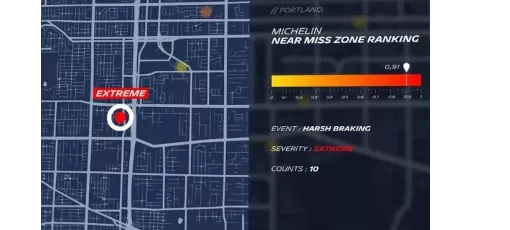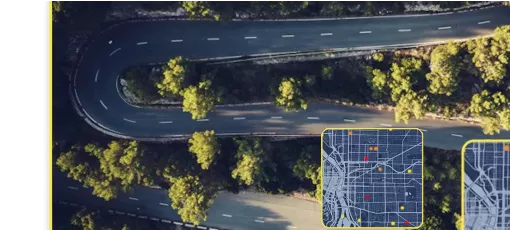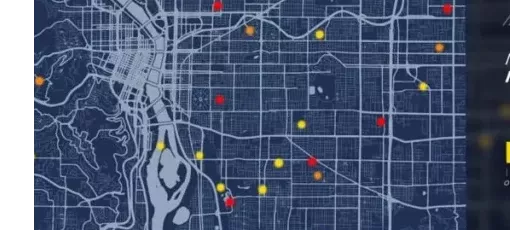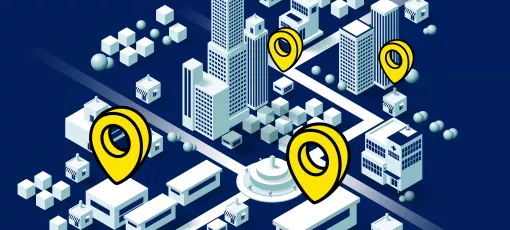
Excessive Speeding
Description
Description
Our ‘Excessive Speeding' service allows you to identify and locate where and when excessive, over the speed limit, driving behaviors occurred. These can indicate risky behaviors and a potential ‘Near Miss’ incident waiting to happen.
Key Features:
- Atypical excessive speeding driving events clusters
- Weather, solar and day of the week contextualization
- Filtering by road features and driving events
- Before/after comparisons
- Compatible with any GIS
Want to go one step further ?
Our add-on service 'Detailed driving events' allows you to get detailed information on individual driving events such as :
- Event type
- Date, time, day of the week
- GPS coordinates and speed at the beginning and end of the trip
- Context : weather ...
and much more...
Product sheet
Product sheet
file_download
Download
Benefits
Benefits
LEVERAGE DATA INSIGHTS
Based on millions of connected drivers, understand where and when road safety issues may arise tackling atypical driving events to complement past crash data.
INTEGRATE EASILY
All information slips onto geographic information systems, enhancing other data sets and with no other infrastructure requirements.
ALLOCATE RESSOURCES
Justify and allocate the right resources at the right time and place based on a easily measurable new safety KPI.
BEFORE/AFTER ANALYSIS
Monitor and quickly valorize your actions through before / after analysis that you can create independently directly on your GIS.
Usecases
Usecases
Paving the way toward vision zero with MICHELIN DDi Near miss service suite
Combining expertise in data analysis and driving behavior, MICHELIN DDi creates solutions to go beyond crash data reports and act before accidents happen. Leveraging millions of connected vehicules and using machine learning and proprietary algorithms, our Near Miss services suite allows road safety officials to detect, locate and assess atypical driving behaviors indicative of potential near miss incidents.
The output?
A game-changing perspective to go beyond past crash data. With near miss data comes the potential to identify risky zones and act before crashes occur to reach vision zero goals.
Want to know more? Have a look at our separate near miss events offer : Harsh Braking, Harsh Acceleration, Phone Handling and Suspected Collision.
Related products
Quick Start guide
Quick Start guide
Prerequisites
An active account either with " Freemium " subscription (number of requests is limited to 5), or a " Business " subscription to the selected service.
Use of the APIs
The use of all our APIs is subject to the use of a user token. To obtain this token, it is necessary to authenticate by an API call.
The authentication allows to get the user token which will be requested in all the API calls.
The url to use: https://api.ddi.michelin.com/ddi/auth/token
Input parameters:
- grant_type: Type of grant. The only accepted value is “client_credentials”.
- client_id: Your customer id. You can find it in your account page (sample: zbQZOqNEAlKuL[…truncated sample..]0K07AyOk).
- client_secret: Your secret password. You can find it in your account page (sample: BZGn8fZu[…truncated sample…]).
Sample using Curl:
curl –-location --request POST 'https://api.ddi.michelin.com/ddi/auth/token'\
--header 'Content-Type: application/x-www-form-urlencoded'\
--header 'Accept: application/json'\
--data-raw 'grant_type=client_credentials&client_id= zbQZOqNEAlKuL[…truncated sample..]0K07AyOk&client_secret= BZGn8fZufqXXXXXX'
Then, the token must be added in the header of the request:
curl --location --request GET 'https://api.ddi.michelin.com/risky_turns/turns?distance=1&long=3.05167&lat=45.9153'\
--header 'Accept: application/json'\
--header 'Content-Type: application/json'\
--header 'Authorization: Bearer eyJraWQiOiJxMXl2M[…truncated sample…] EnWxN67fggh1Q'
Sample using Swagger:
1. Select POST /ddi/auth/token and click on “Try it out”
2. Fill in the input parameters specified above
3. Execute to get your token within the response as below:
{
"token": "eyJraWQxMXl2[…truncated sample…]nWxN67fggh1Q"
}
4. Select the “Authorize” button on the top right corner of the Swagger:
5. Copy and paste the token in the field before validating.
The token will then be automatically used in all API requests.
We recommend you to use the paths below for the first tests:
Authorized parameters using Freemium access
countryCode = US
stateCode = UT
cityCode = 84044, 84108, 84119, 84116, 84109
periodStart = 2020_01
periodEnd = 2020_01
Trial & Pricing
Use our freemium tier to explore our insights and test all functionalities for free to start building today !
Real data sample
5 calls
3 months trial period
Let's get started: Use our mobility data as part of your road safety strategy and benefit from support !
Real data
Unlimited calls
Monthtly updates











